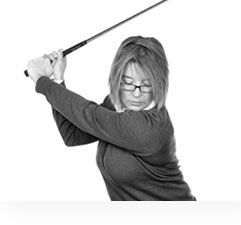 Natalie Adams – PGA Teaching Pro
Natalie Adams – PGA Teaching Pro
If you’re a lady golfer who takes divots as you play your golf shots these can play or provide valuable information to you that you can then feedback into your golf swing to help you improve. So if we look at how you should look at divots, there’s two ways that you can get information from your divots. First of all before you hit your golf shot if you put a marker down so if you – we just use this coin to represent basically where the ball is going to be opposite as you are hitting your shot. Okay the white piece of paper represents the divot. So if we see that once the ball's gone the divot has started before the position of the coin it means you’ve hit the ball slightly flat. Now if this is happening the gold club is hitting the ground before it’s hitting the ball, you’re actually de – or going to start slowing the club down, it’s going to be decelerating as it gets to the ball because obviously the ground has taken the energy from the club and is slowing the club down as it, as the club collides with it.
So looking at this you’d want to try and move your divot to start more opposite where the coin is and that’s the correct position. So you should see that better players would hit the ball so they would take the ball from opposite the coin and then the divot would start just after the ball. So that’s what we’re looking for, that’s ensuring that you’re striking the ball first and then striking down into the divot. That’s going to allow you to get a really high ball flight. The club is going to be doing all the work for you. So that’s one way to look at divots to see if you’re actually striking the ball first or if you’re not making a good connection, how to improve that connection. We can also look at your divots at – from this direction as well. So once you’ve hit the golf ball, stand back behind the ball and actually look at where the divot is pointing to. So if your ball is then flown in line with that divot that shows that the club face was pointing in that direction and the divot is showing that the club head was moving in that direction as you struck the ball.
So you can then get some information on that to – if that’s the correct shot that you wanted to hit then you can repeat doing that. If the ball is flown over to the left you need to start working on the club face position and try to get the club face position more to the right than on the last shot. And certainly if you see your divots pointing out to the right that’s also going to give you valuable information that you can then feed back in with your next swing. So looking at your divots really, really important. It gives you information on how you’ve connected with the ball, if you give it maximum speed and club head speed into the ball to create most distance with your shots. And also we can look at it to give us information over directional control and to help us learn how to hit straighter golf shots.





